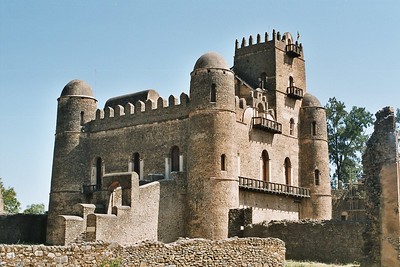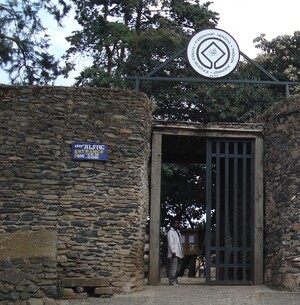Fasil Ghebbi

Fasil Ghebbi, Gondar Region, covers the remains of a fortress-city that represents Ethiopian civilization on the highlands and influenced Ethiopian architecture.
Fasil Ghebbi was the residence of the Ethiopian emperor Fasilides and his successors in the 17th century. The walled compound functioned as the centre of the Ethiopian government until 1864. Its architecture was inspired by the Baroque style that was introduced by Jesuit missionaries. The site comprises the buildings within the fortress and also seven further Ethiopian-Orthodox monasteries and palaces in and around the city of Gondar.
Community Perspective: It’s an amazing place to discover, with its Medieval European/Moghul-like buildings. Wojciech recommends visiting the Gemja Ber Marjam (or Debre Birhan Selassje) church for its paintings.
Map of Fasil Ghebbi
Load mapCommunity Reviews
Wojciech Fedoruk

Gondar is the third permanent capital of the Ethiopian Empire (the first was Aksum, the second was Lalibela, after which there was a period in which the capitals changed very often). Finally, Emperor Fasilides, who reigned from 1632 to 1667, moved the capital to the high-lying Gondar and built the first palace there, still named after him today. Subsequent rulers had no less ambitions, each of them added their own palace next to it, of which there are four in the complex of Fasil Ghebbi. In addition, there is a library, a steam sauna and cages of Ethiopian lions, animals that were the symbol of emperors.
The complex clearly resembles the style of medieval European castles or Moghul architecture, although our guide swore that it was built only by Ethiopians. It looks great from the outside, but inside it is much worse - there is nothing left but bare walls, the walls are covered with bird droppings. Additionally, some of the roofs were destroyed by British bombing during World War II (Italian soldiers were stationed in the complex). Nevertheless, the complex looks magnificent, having no equivalent in sub-Saharan Africa. Fasil Ghebbi was included on the WH List along with some other buildings from this period. And those buildings are not to be missed.
Some of them are located outside Gondar and we had no time for them. But we visited the wonderful Gemja Ber Marjam (or Debre Birhan Selassje) church, with unique paintings on the walls and ceiling. The ceiling paintings of angels in particular have no equivalent anywhere else in Ethiopia. The church almost miraculously did not suffer any damage during the Mahdi Uprising, when the Sudanese destroyed almost all Christian churches in northwestern Ethiopia. Apparently he was protected by wild animals, sent by God himself.
We finished our tour of Gondar at the Baths of Fasilides, located a bit further away, but still within the city. The complex is extremely charming, and during Epiphany thousands of believers immerse themselves in the pool. Additionally, the positive impression is enhanced by the wall surrounding the pool, the coexistence of which with the surrounding trees is vividly reminiscent of Angkor.
All in all, very pleasant site. It is easily reached even during the state of emergency (January 2024) as there are frequent flights from Addis Ababa or Lalibela. We took the latter and the flight took about 30 minutes.
James Larsen
The road from the south from Bahir Dar goes along Lake Tana up to Gondar. Along the way is a heritage site that has ruins left from a 1500's castle with Portuguese influence where you would never expect to see it. Entering Gondar and seeing this magnificent and very much in tact site with many buildings was well worth the trip. And there are otehr things to do around this area including the famed Church with the angel faces.
Els Slots

My first view of Gondar's heydays fell upon Fasiladas Baths. This pool lies in a rustic setting somewhat out of town. Sitting on the steps leading to the water, you can only imagine what it looks like during a major religious festival.
In the center of town, you find the Royal Enclosure. Here four castles and several other buildings from the 17th century remain. Still, the most prominent one is that of King Fasilades himself. Round-shaped towers characterize this European / Moghul-looking castle.
The whole historic area is amazing, and a pleasure to be in. Gondar's modern town is also a nice place to spend a few days.
Community Rating
- : David Marton Dolemite92
- : Hanming Roger Ourset Jean Lecaillon Roland Krijn Juha Sjoeblom
- : Wojciech Fedoruk Els Slots Patrik_globe Thomas Kunz Rvieira Philipp Leu Szucs Tamas Adrian Turtschi Tony0001
- : Randi Thomsen Svein Elias Michael Ayers Ammon Watkins Lucio Gorla
- : Solivagant
- : Alexander Barabanov Jon Opol
- : Thomas van der Walt
Site Info
Site History
1979 Inscribed
1978 Deferred
Bureau - ICOMOS want more info
Site Links
Connections
The site has 20 connections
Art and Architecture
Constructions
Damaged
History
Religion and Belief
Science and Technology
Timeline
Trivia
WHS Names
WHS on Other Lists
World Heritage Process
Visitors
79 Community Members have visited.
The Plaque
 (photo by Jarek)
(photo by Jarek)